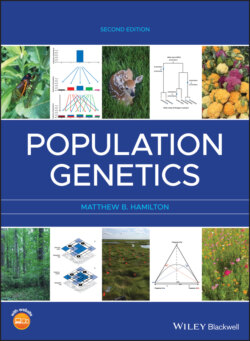Читать книгу Population Genetics - Matthew B. Hamilton - Страница 31
Problem box 2.2 Proving allele frequencies are obtained from expected genotype frequencies
ОглавлениеCan you use algebra to prove that adding together expected genotype frequencies under hypotheses 1 and 2 in Table 2.7 gives the allele frequencies shown in the text? For the genotypes of hypothesis 1, show that f(aa bb) + f(A_ bb) = fbb. For hypothesis 2, show the observed genotype frequencies that can be used to estimate the frequency of the B allele starting off with the relationship fA + fB + fO = 1 and then solving for fB in terms of fA and fO.
Table 2.7 Expected numbers of each of the four blood group genotypes under the hypotheses of 1) two loci with two alleles each, and 2) one locus with three alleles. Estimated allele frequencies are based on a sample of 502 individuals.
| Blood | Observed | Expected number of genotypes | Observed – Expected | (Observed – Expected)2/Expected |
|---|---|---|---|---|
| Hypothesis 1: fA = 0.293, fa = 0.707, fB = 0.153, fb = 0.847 | ||||
| O | 148 | 502(0.707)2(0.847)2 = 180.02 | −32.02 | 5.69 |
| A | 212 | 502(0.500)(0.847)2 = 180.07 | 31.93 | 5.66 |
| B | 103 | 502(0.707)2(0.282) = 70.76 | 32.24 | 14.69 |
| AB | 39 | 502(0.500)(0.282) = 70.78 | −31.78 | 14.27 |
| Hypothesis 2: fA = 0.293, fB = 0.153, fO = 0.554 | ||||
| O | 148 | 502(0.554)2 = 154.07 | −6.07 | 0.24 |
| A | 212 | 502[(0.293)2 + 2(0.293)(0.554)] = 206.07 | 5.93 | 0.17 |
| B | 103 | 502[(0.153)2 + 2(0.153)(0.554)] = 96.85 | 6.15 | 0.39 |
| AB | 39 | 502[2(0.293)(0.153)] = 45.01 | −6.01 | 0.80 |
The number of genotypes under each hypothesis can then be found using the expected genotype frequencies in Table 2.6 and the estimated allele frequencies. Table 2.7 gives the calculation for the expected numbers of each genotype under both hypotheses. We can also calculate a chi‐squared value associated with each hypothesis based on the difference between the observed and expected genotype frequencies. For hypothesis 1, χ2 = 40.32, whereas, for hypothesis 2, χ2 = 1.60. Both of these tests have one degree of freedom (4 genotypes −2 for estimated allele frequencies −1 for the test), giving a critical value of χ20.05,1 = 3.84. Clearly, the hypothesis of three alleles at one locus is the better fit to the observed data. Thus, we have just used genotype frequency data sampled from a population with the assumptions of Hardy–Weinberg equilibrium as a means to distinguish between two hypotheses for the genetic basis of blood groups.
